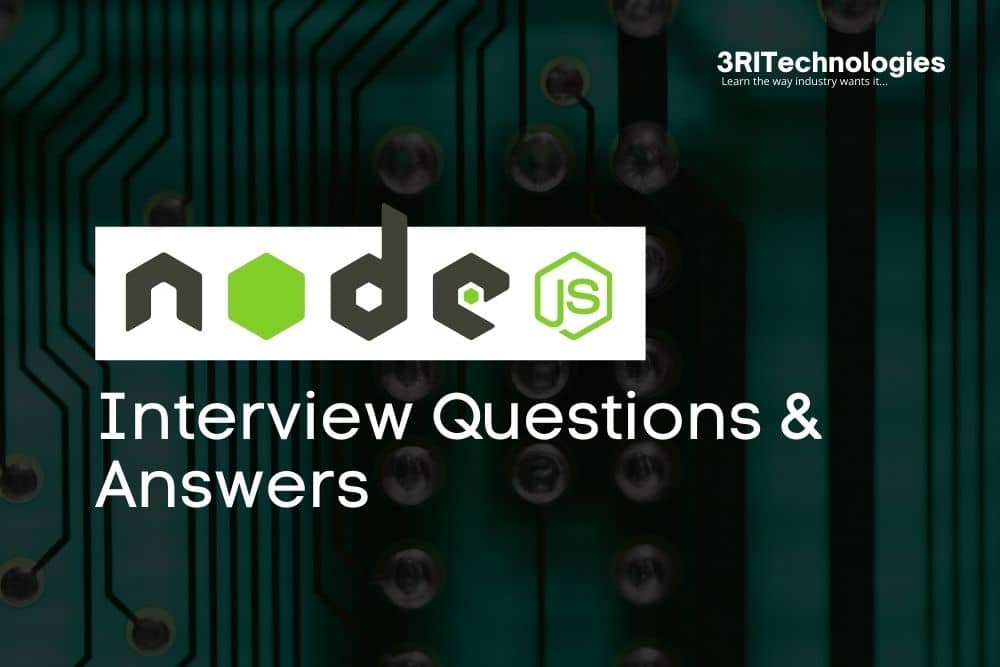Nowadays, more and more organizations are using NodeJS, the popular server-side platform. This server-side platform was introduced in 2009. Node has the JS environment, which is used to execute the code of JavaScript outside the browser. NodeJS is based on Google chrome’s V8 engine. Many top MNCs and Indian platforms demand JS developers. Hence, their demand has increased the popularity of NodeJS amongst individuals.
If you’re preparing for a developer role, understanding the most frequently asked Node.js interview questions is a must. This page presents well-curated Node.js interview questions and answers suitable for freshers, intermediates, and experienced professionals. Whether it’s your first interview or you’re targeting a senior role, these Node.js interview insights will give you the edge. Take your preparation a step further with MERN Stack Training from 3RI Technologies. Gain hands-on experience and become job-ready with in-depth coverage of Node.js, MongoDB, Express, and React—all in one powerful stack.|
If you are an aspirant of NodeJS, you should start brushing up your skills on this platform. The candidates seeking to get the job of NodeJS developer must start their preparation with these NodeJS interview questions. Although few node interview questions are common and asked by every interviewer. But the below-given set of NodeJS interview questions advanced will help you stand out of all the candidates in the queue.

Most Asked Node.js Interview Questions for Freshers & Experienced Professionals
1- Explain the function of the first class in JavaScript
The functions treated with any other variable then these functions are said to the first-class functions. Many programming languages like Scala, Haskell, and more use first-class functions. The class function can be passed as a param to another function (callback), or the function can return other functions (higher-order function), map(), and filter(), which are high order popular functions.
2- Describe NodeJS and its working
A virtual machine that uses JavaScript as the scripting language and runs on chrome V8 JavaScript engine is called the NodeJS. It is based upon the event-driven architecture where I/O runs asynchronously, making the NodeJS lightweight and efficient. NodeJS is used to develop desktop applications with the popular framework named electron because it provides API for accessing OS-level features like file system, network, and more.
3- How to manage packages in the NodeJS?
Packages can be managed by several package installers with their configuration file accordingly. Packages mostly use NPM or yarn. Both NPM and yarn provide libraries of JavaScript, which have features of controlling environment-specific configurations. For the maintenance of versions, libs have been installed in the project, which uses package.json and packagelock.json, after which the issues of proving the app will not arise in a different environment.
4- In what way is NodeJS better than other frameworks?
How NodeJS is better than other frameworks is
● With NodeJS, simplicity in development is being provided due to the non-blocking of I/O and even based model, resulting in short response time and concurrency. It is not like other frameworks where developers use thread management.
● NodeJS runs on a chrome V8 engine written in C++ and is highly performant with continuous improvement.
● JavaScript is utilized in both the development of the frontend and backend.
● NodeJS has a lot of libraries that arise from the reinvention of the wheel.
5- Mention the timing feature used in NodeJS
Some timing features used in NodeJS are
● setTimeout/clearTimeout, which is used for implementing delay in the execution of the code.
● setInterval/clearInterval used for running the code block multiple times.
● setImmediate/clear immediate used in the execution of the code at every end of the loop cycle.
● process.nextTick used in the execution of code at the beginning of the loop cycle.
6- Why use promises instead of callbacks?
Promises offer an object for deciding the action which needs to be taken at the sync of the competition of the tasks. Promises give more effortless code for avoiding callback hell.
7- Define fork
Generally, the fork is used for spawning child processes. While in Node, the fork is used to create a new instance of engine V8, which can be run on multiple workers for executing the code.
8- Mention the reason why NodeJS is single-threaded
NodeJS is created as the experiment in the syncing process. It has been created to give the new theory of doing the syncing process in the single thread over other thread bases implementing scaling through different frameworks.
9- How to create the simple server of NodeJS which returns hello world?
var HTTP = require (“HTTP”);
HTTP.createServer(function (request, response) {
response.writeHead(200, {‘Contest-Type’: ‘text/plain’});
response.end(‘ Hello World\n’);
}).listen (3000);
10- Mention the assertions which async.queue takes as the input
Task function and concurrency value are the two assertions that the async.queue takes as input.

11- State the purpose of the module.exports
Module.exports have been used to expose the function of the particular module or file that needs to be used elsewhere in the project. In addition, it can be used to encapsulate all similar functions in the file, which improves project structure.
12- Which tool can be used for assuring consistent code style?
ESLint is the tool that can be used with IDE for ensuring consistent coding style, which helps in the maintenance of the codebase.
13- Give an example of callback hell
async_A (function(){
async_B (function(){
async_C(function(){
async_D(function(){
…..
});
});
});
});
14- Define event loop
Async is being managed by an event loop that uses queue and listener. When the async process is committed, the central cord sends the rope authorizing V8 to maintain the fundamental protocol’s performance. It involves various phases with particular tasks like timers, pending callbacks, idle or prepare, poll, check, close callbacks in different queues.
15- State the example as how NodeJS handles concurrency
const crypto = require (“crypto”);
const start = Date.now();
function logHashTime() {
crypto.pbkdf2 (“a”, “b”, 10000, 52, ” sha52″, () => {
console.log (” Yash: “, Date.now() -start);
});
}
logHarshTime();
logHarshTime();
logHarshTime();
logHarshTime();
16- List the difference of process.nextTick() and setImmediate()
Both the functions can be used for an asynchronous mode of operation through the listener function. process.nextTick() sets callback for executing and on the other hand setImmediate() used to place the function in the next phase of the event queue.
17- How has NodeJS overcome the problem of blockage of I/O operations?
NodeJS has the event loop, which can be used in asynchronously handling the I/O operations without the blockage of the primary function.
Interested to begin a career in NodeJS? Enroll now for Mean Stack Training in Pune.
18- Give the example of using async await
// this code is to retry with exponential back off
function wait (timeout) {
return new Promise( (resolve) => {
setTimeout( () => {
resolve()
}, timeout);
});
}
async function requestWithRetry (URL) {
const MAX_RETRIES = 10;
for (let I = 0, I<= MAX_RETRIES, I++) {
try {
return await request(url);
} catch (err) {
const timeout = Math.pow(2, I);
console.log(‘Waiting’, timeout, ‘ms’);
await wait(timeout);
console.log(‘Retrying’, err.message, I);
}
}
}
19- Define NodeJS streams and state their types
The streams are the EventEmitter which are used for working with the streaming data under NodeJS. It can be used for handling and manipulating large videos, mp3, and networks. Streams use buffers as temporary storage. Streams mainly can be classified as
● Writable
● Readable
● Duplex
● Transformation
20- Define NodeJS buffers
Generally, buffers are the memory used in streaming or hold on to the data until consumed. In Node, JS buffers have been launched with the additional use of JavaScript Uint8Array, mainly used to represent a fixed-length sequence of bytes. It also supports legacy encoding such as ASCII, utf-8, and more. Buffers are fixed allocated memory of V8.
21- Describe the meaning of middleware
It comes in between requests and business logic. Middleware is used in capturing logs and enabling rate limit, routing, authentication, and more. But it’s not a part of business logistics. Middleware is a third party like body-parser, which one can write on their fore specific case.
22- What is the reactor pattern?
It is a pattern for blocking I/O operations. But generally, reactor patterns can be used in any event-driven architecture. In the reactor pattern, there are mainly two components as reactor and handler.
23- State the reason for separating express app and server
The reason is that the server is responsible for initializing routes, middleware, and various other application logics because the application has the business logic, which is served by the routes initiated through the server. Thus, it ensures that the business logic is encapsulated and decoupled from application logic for making the project readable and maintainable.
24- What is the reason for the usage of the V8 engine in Google?
NodeJS uses google’s V8 because it is the most involved and fastest JavaScript one has got till now. Also, it is very portable to numerous machines.
25- Define exit codes
Exit codes give the idea of how the process will get terminated. Few exit codes which are commonly used are
● Uncaught fatal exception
● Unused
● Fatal error
● Internal exception handler run time
● Internal JavaScript evaluation failure
26- Define the phenomenon “stub.”
These are used in writing tests which are an essential part of the development. Stub replaces the whole function during its testing.
27- How to enhance NodeJS performance with clustering?
The application of NodeJS runs on a single processor, which means that it doesn’t take advantage of multiple core systems during the default. Instead, the cluster mode is used for starting multiple NodeJS processes, which have numerous instances of the event loop. When the cluster in NodeJS starts using behind the scenes, multiple NodeJS is created in the cluster manager process.
28- Define thread pool and state which library handles thread pool in NodeJS
It is handled by the libuv library, which is the multi-platform C library that provides asynchronous I/O-based executions of the file system, networking, and concurrency.
Check out MERN Stack Training in Pune. Enroll now!
29- Describe WASI and state the reason why it is launched?
The web assembly provides web assembly system interface specification WASI API using WASI class in NodeJS. The introductory part of WASI is being done by keeping in mind to use the underlying operating system to collect POSIX-like functions, which enable the application for using the resources more effectively and features that require system-level access.
30- How are worker threads different from clusters?
| Cluster | Worker threads |
| It is the process on CPU with IPC for communication. | It is the process in total with numerous threads. |
| If people want to have multiple servers which accept HTTP requests, the cluster provides a single port. | Every thread has Node instances with most of the API accessible. |
| The need in the CPU spawns the clustering process; thus, it will separate the memory and Node instances, leading to memory issues. | It can share the memory with other threads. |
31- List out the reasons for using NodeJS
With NodeJS, the building of scalable network programs becomes easier. The reason for using NodeJS is because it offers many advantages. Some of them are
● NodeJS is faster than other frameworks.
● NodeJS has to block features.
● NodeJS provides a unified programming language and data type.
● NodeJS is asynchronous.
● NodeJS yields high concurrency.
32- List the application where Node is mainly used
NodeJS can be used in the following applications
● Chats of real-time.
● Things from internet
● Complexity of SPAs
● Collaboration tools are real-time
● Application streaming
● The architecture of microservices
33- Share the distinction between front end and back end advancement
| Front end | Back end |
| It refers to a client-side application. | It is the server-side of the application. |
| The front end is the part of the web application which the user can see and interact with. | The backend has all that happens behind the scenes. |
| The front end includes attributes to the visual aspects of the web application. | It has a web server that communicates with a database for serving requests. |
34- State the difference between Node and Angular
| NodeJS | Angular JS |
| NodeJS has a server-side environment. | AngularJS has a frontier development framework. |
| NodeJS can be written in C and C++ language. | Angular can write typescripts. |
| It is used in building fast and scalable server-side networking applications. | It is used for building single-page or client-side web applications. |
| It generates database queries. | It splits web applications into MNC components. |
35- State the name of the database used in NodeJS
MongoDB is the most used database in NodeJS. The database MongoDB is the NoSQL, cross-platform, which is document-oriented which furnishes elevated accomplishment, increased availability, and susceptible scalability.
36- Mention the libraries used in NodeJS
The most common libraries used in NodeJS are
● Express JS
● Mongoose
37- State the pros and cons of NodeJS
| Pros | Cons |
| NodeJS is the fast processing event-based model. | It is not suitable for computational tasks. |
| It uses Javascript | It uses callbacks that are complex and can end up with nested callbacks. |
| It had more than 5000 packages. | Cannot deal with relational database |
| It is suited best for a high amount of data operations. | It cannot manage intensive tasks. |
38- How to use URL in NodeJS?
The module URL provides numerous utilities of URL resolution and parsing. In addition, NodeJS has built-in a module that helps split up the web address into the readable format.
39- Define piping
It is the mechanism that is used in connecting the output of one stream with another stream. Piping is used in retrieving the data from a stream that passes to another stream.
40- State the numerous types of HTTP requests
It defines the set of methods that are used to perform various actions.
● GET
● POST
● HEAD
● DELETE
41- How to connect MongoDB with NodeJS?
For connecting MongoDB with the database, the following steps can be performed
● It starts by creating a MongoClient object.
● It specifies the URL connection with the appropriate IP address and name for the database.
42- State the difference between NodeJS and AJAX
The primary difference between both is that AJAX uses client-side technology, which is used to update the page’s content without refreshing.
NodeJS uses server-side JavaScript, which is used in the development of server software. Therefore, it doesn’t execute in the browser but in the server.
43- Name the challenge faced by the users of NodeJS
NodeJS most emphasizes the technical side. It has one process with a thread for scaling up in a multi-core server.
44- Describe the difference between asynchronous and non-blocking
| Asynchronous | Non-blocking |
| Asynchronous doesn’t make HTTP requests, which means that they don’t wait for the server’s response. Instead, Asynchronous continues with block and responds to the server response whenever received. | It is used with IO. First, it calls return with whatever and accepts the caller to execute the call again. Then, it will read until it has various data to put the calling thread to sleep. |
45- Define tracing
With this phenomenon, the tracking information will be generated by the Google V8 engine. The code of NodeJS and userspace will be in the log file. This system will be enabled by –trace-events-enabled flag at the beginning of the NodeJS application. The running of NodeJS will produce the log files, which can be opened in the chrome tab.
46- How to debug an application in NodeJS?
The NodeJS includes the debugging utility as a debugger. For starting the application, debug needs to be followed by the path with the debug script. In addition, it deposits the declaration debugger, which the quotation of the script will encourage the breakpoint of the posture in the statute.
47- List the difference between setImmediate() and setTimeout()
Both the functions are somewhat similar but also has some dissimilarity as
● setImmediate() is being designed for executing the script when the current poll phase completes.
● setTimeout() is designed for scheduling the script, which will be run after the minimum threshold elapsed.
48- Define process.nextTick()
Other functions like setImmediate() and setTimeout() are the part of event loop. But process.nextTick() isn’t part of the event loop. Moreover, this function will operate when the current operation completes regardless of the phase of the event loop. However, when process.nextTick() has been called, it will be resolved before the event loop continues.
49- Explain Libuv and state its feature
A multi-platform that supports the library with asynchronous IO focus is called the libuv. When it was launched, it is only used in NodeJS, but it is slowly used in various other frameworks. Libuv offers many features, which are given below
● The entire feature event loop is backed by epoll, kqueue, IOCP, and event pots.
● Libuv has an asynchronous TCP and UDP socket.
● It is operated on the asynchronous file system.
● Libuv has the child process.
● It has file system events.
50- Point the difference between readable and createReadStream
| createReadStream | readFile |
| It can read files in chunks of the size 64kb, which can be specified beforehand. | It can provide only asynchronous reads in the entire content. It will read the whole file before presenting it to the users. |
As you start your preparation for being a Nodejs developer, the comprehensive guide of NodeJS interview question answers will help you a lot during your practice. If you prepare for these questions and answer well, you will crack your interview with five stars. Also, through this guide, you may have got an idea of NodeJS interview questions for freshers, which will be asked during the interview. If you want to know more about NodeJS course, then do check the 3RI Technologies website.







